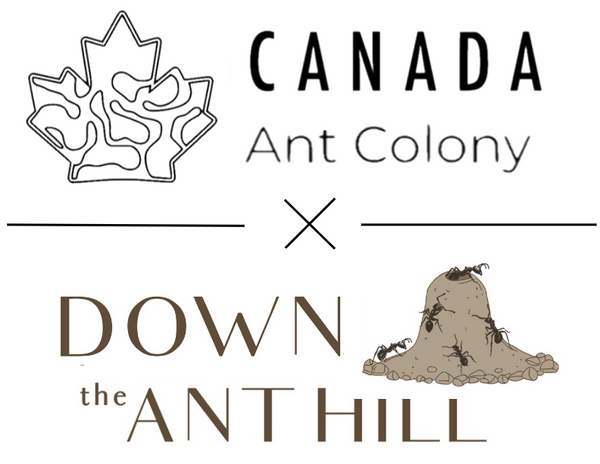For some, termites are pests; for others, they’re intriguing creatures to raise as pets or use as food for other animals like chickens, reptiles, and ants. This guide focuses on rearing termites, which, like ants, can be kept successfully with the right knowledge and care. Establishing a termite colony is relatively straightforward, though long-term maintenance can be more challenging.
Here in Canada, we sell Giant Dampwood Termites and Subterranean Termites here.
Methods for Starting a Termite Colony
In termite colonies, primary reproductives—the king and queen—are the original founding members. They pair up during a mating flight, settle down, and establish the first generation of workers and soldiers that will tend to the nest. Over time, they produce winged alates, which disperse to form new colonies. When a queen dies, workers often become secondary reproductives (neotenics), or worker reproductives to help maintain the colony’s growth. These secondary queens will then mate with the existing king or queen to continue producing workers, soldiers, and alates, even if the original pair dies.

Reticulitermes termite workers
In many species (including all Canadian termites), secondaries can fully replace primaries, sustaining the colony’s productivity and even producing alates themselves. This is unlike ants, where typically only a single queen handles reproduction, and no “backup” queens (akin to termite neotenics) exist to replace her in most cases.
Thus, there are two main ways to start a termite colony:1. From Primary Reproductives (Kings and Queens)
2. From Secondary Reproductives (Workers)
We sell both Kings, Queens, and Worker Groups.
Method 1: Starting a Colony from Alates
One of the easiest and most efficient ways to start a colony is by capturing alates, or flying reproductive termites. Alates are released during termite swarms, often triggered by rain, and are drawn to lights, making them relatively easy to collect.

Pair of Zootermopsis angusticollis
1. Capture Alates:
- During a termite swarm, locate alates near streetlights or other bright sources. They’ll shed their wings soon after landing.
- Observe the alates as they pair up in a behavior called “tandem running,” where a male follows a female while touching its antenna to her abdomen.
2. Setting Up the Colony:
- Materials: Gather a test tube, and a substrate, such as cotton (for Subterranean Termites, or Reticulitermes) and rotten wood (for Giant Dampwood Termites, or Zootermopsis)
- Add water to ¼ of the test tube to provide moisture. Insert the substrate (moistened, but not too wet, as excess humidity can harm termites).
- Make a small hole in the substrate for the alate pair to dig in, place them in the tube, then close it and leave the setup in a dark place. Avoid frequent checks, as stress can cause them to eat their own eggs or offspring.
Alternatively, you can create a similarly viable setup with a petri dish filled with wood.
Wood Selection: Wood rot typically has three components: cellulose, hemicellulose, and lignin. Termites generally feed on the cellulose (the white part). Zootermopsis in particular seem to need nitrogen rich wood. Typically the best wood will have some level of rot. Mushrooms growing out of the wood are a good indication of this.
3. Nurturing the Colony:
After about a month, the pair should produce larvae (which look like tiny termites), which will eventually mature into workers and soldiers. Depending on species, termites will need specific food, such as wood or even humus-rich soil
I find that Zootermopsis termites specifically do better when given an additional source of protein, such as through feeder insects occasonally.
Method 2: Starting a Colony from Secondary Reproductives
Using secondary reproductives, or “neotenics,” is another effective approach for establishing a termite colony. Neotenics develop in response to the absence of the colony’s primary royal scent.
1. Starting the Colony with Neotenics:
- Collect termite workers (and optionally soldiers) and place them in a larger setup with ample food. Without a queen’s presence, some workers may molt into ergatoid neotenics.
- Provide plenty of substrate and space, as the colony will expand more rapidly once neotenics take over reproduction.

Subterranean Termite Colony in Petri Dish
Long-Term Maintenance and Care
Rearing termites involves more than just setting up a colony; maintaining it in the long run requires close attention to the species’ specific needs.
1. Environmental Conditions:
- Match substrate and moisture levels to the species, using wood for wood-eaters and humus-rich soil for soil-feeding termites.
- Place the colony in a dark, undisturbed area to reduce stress on the termites
- It is vital to ensure the termites stay hydrated and that there remains water in the setup (for subterranean and dampwood termites)
2. Feeding:
- Each species has particular food requirements:
- Wood-feeding species like **Kalotermitidae** and **Rhinotermitidae** will consume wood or tissue.
- Monitor food levels, ensuring a consistent supply for growing workers and soldiers.
3. Monitoring Health:
- Regularly check the colony for food levels and any signs of stress or illness. However, limit direct handling, as excessive disturbance can lead to colony decline.
With careful setup and patience, a termite colony can become an interesting and sustainable addition to a pet or research environment. Whether for study, companionship, or as a food source for other animals, raising termites offers a fascinating glimpse into their complex social structure and adaptability.
